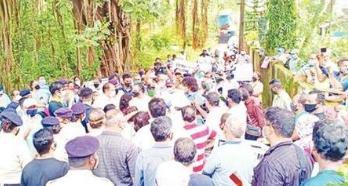
Sujay Gupta
Agnelo Billy Pereira, Billy to all, sits on his easy chair on his balcao in Utorda not far from the Nossa Senhora de Lourdes Igreja em Utorda (The Lady of Lourdes Church). His mind traces back to the days of the Konkan Railway agitation against the proposed alignment of the new railway line named after the linguistic region they chose to serve.
About three decades later, the same Konkani speaking people living along the tracks of the Konkan Railway and South Western Railway in coastal Salcete and Mormugao, are bracing themselves by gearing up to fight against the triple jeopardy, the double tracking of the existing South Western line, to basically allow wagons to carry coal of big daddy industrialists who support the government.
Billy, who was in his twenties then remembers the movement vividly and also the role of the Church in that agitation led mainly by the Parish priest of Utorda Fr Jose Dias. Across Majorda, Utorda, Seraulim and Cansaulim the movement against the Konkan railway agitation was not just about realigning their tracks. It was against the realignment of their futures, their heritage, their ways of life. It was against the basic principle that governs all land acquisition, where the centre has the right to literally bulldoze all local opposition in the name of national projects.
For Billy, this is Deja Vu. Close to thirty years ago the rumblings were felt. The ground beneath their feet rumbled and shook at the shock of a railway track piercing their way of life and bulldozed its way out of all opposition but the people of this part of Goa stood their ground.
Alvaro de Assuricao Pereira, a musician, well known in these parts and a long-standing member of the local choir, heard very discordant notes from the government justifying the need for aligning the track in a manner which would cause maximum damage. He plunged headlong into the agitation. And faced police action. “One day I was getting ready to go for a wedding and saw policemen come to my house and tell me that there is an arrest warrant and that I had been summoned by the court. I reached out to a prominent local politician who advised me to go and respond to the summons”, he said indignantly, not too pleased, even now at the politician throwing him to the wolves as it were. “Anyway, I went and spoke to the authorities and was first allowed to go to the wedding. The issue was then sorted out.”
Three decades later, he finds himself beginning to be in the centre of another people’s movement, this time against the laying of a third track of the South Western railway. But in Utorda, it doesn’t actually eat into homes but the new tracks in some stretches near the Church will literally block their front entrances and block them totally.
So this double tracking is actually a triple jeopardy for the villagers of Utorda. First, there was the South Western Railway, then came the Konkan Railway and now the process of acquiring land as well as constructing on already acquired land (in most of Utorda) has commenced. This, in short, is triple jeopardy.
On the day after this writer's lovely meeting with Billy, a small group of men and women made their way, on a cloudy day to where their lives, both personal and social revolves around, The Lady of Lourdes Church. The Church, as we know is closed but it has folks there with hearts big enough to take on another railway project.
Freda Pereira was only seven when agitation for the realignment of the Konkan Railway line happened. But her home on the tracks in Utroda reverberates with memories, of her grandfather Gregory Pereira, one of the leading local lights of the agitation. Her home still reverberates. But this time also from the vibrations of the passing trains leading to cracks in her wall which are filled up with a coat of paint only to crack again.
But this fight against the cracks on her wall is akin to the fight against the tracks right outside her house. She doesn’t give up. A zesty young fighter for causes, she gives hope that a people’s movement is in the right hands if her kind are the building blocks of a peoples struggle. At the Church on Friday evening, she and many others gathered. They had masks on and a fair healthy distance between most, but speaking about the Konkan Railway agitation and the long road ahead to stop the triple jeopardy, brought them even closer.
Importantly, people of Arrosim, Cansaulim and Velsao, in an amazing show of solidarity were there to give a simple message to the people of Utorda. It doesn’t matter if homes are actually getting lost or not. This was a greater question to be asked “Why do peoples genuine concerns, their heritage, their identities and their futures be decided only in terms of compensation and resettlement and development. Stanley Barros Pereira who resides next to the tracks in Cansaulim and has his furniture workshop next to the tracks in Utorda pertinently says “Everyone in each of the villages must understand the long term impact of these projects. And local leadership has to emerge.
Take the village of Seraulim, which opposed the Konkan Railways project in 1992-1993 for instance. In 1993, shoot-at-sight order against protesters was issued. Now, it’s also where a big resistance against the doubling of tracks for coal is emerging.
As Barros Peeeira says “We were steamrolled. But should we let that happen again?”
According to another report online one of the people in the agitation, a retired banker from Seraulim Vincente Fernandes, 62, a veteran of the Konkan Railway agitation had said, “We will have to agitate again. We are not talking of one more train. The doubling of tracks means, 20-30 trains more. There is no access to our homes, no bridges to walk to the other side, no roads made friendly for us.” Though this columnist did not meet Fernandes (yet), what he said, in the report was very pertinent and deserves this mention.
Sao Jose de Areal is going to another nerve centre of this movement. On November 24, 2017, the Railways confirmed that they require 3338 sq mts plus 7183 sq mts of additional land. In September they came to the village to take measurements but were sent back by the residents who surrounded the officers.
Section 20A of Railways Act 1989 to acquire the required land stares at people. None of them are criminals and lawbreakers. Each of them loves their land and their fight is not just about self-preservation but about the land they love. The letter of the law has to contend with the spirit of the people and not in a manner that might or the perception that the state is always right.
As trains continue to race past these villages and the little meeting draws to the close you see people with fire in their bellies and their hearts heavy. One of the many reasons for this is also the lack of leadership, of guidance, of support from the political dispensation. Quite unlike the Konkan railway agitation when there were political daggers drawn between then Chief Minister Ravi Naik who backed the Konkan Railway route and then Deputy CM Wilfred D'Souza who backed the people wanting realignment of the lines from the coast to the hinterland to do minimum damage.
"This railway line is not meant for Goa and the Goans. Goa is being used just as a corridor," said Wilfred D'Souza, then deputy chief minister of Goa.
Is there a single minister in the Pramod Sawant Government ready to say this to the Chief Minister about the double-tracking of the South Western Railway line, when in effect the line is of no benefit to Goa. Cortalim MLA Alina Saldanha is the lone voice but she too should know that compromises and political balancing will not work. The opposition, with reason and justification, has to be complete.
People still look back at people and organisations which made a movement, a movement. The All Goa Committee for Social Justice and Action which was Church backed. The Konkan Railway Realignment committee (KRRAC) and those who opposed them like the MGP leader Ramakant Khalap led Konkan Railway Anti Realignment Front. Hence Ravi Naik and Khalap of opposite parties found themselves together opposing the people’s movement for realignment.
The current movement is devoid of political voices. It’s almost as if every elected MLA has been frozen into either silence or disinterest. The gap between politicians and people is actually much wider than the distance between any of the railway tracks which are a bone of contention.
The silver lining in this situation though is that people have a clean slate. After all, politics is all about polity. And the polity is on the tracks of Utorda, Cansulim, Velsao, Arrosim, Seraulim, Sao Jose de Areal and others.
It’s now the turn of the people to say ‘bhivpachi garaj na’, when they get no political leadership. The embers of the Konkan Railway realignment agitation may well light the path of the anti- double-tracking movement.
